Services on Demand
Journal
Article
Indicators
-
 Cited by SciELO
Cited by SciELO -
 Access statistics
Access statistics
Related links
-
 Cited by Google
Cited by Google -
 Similars in
SciELO
Similars in
SciELO -
 Similars in Google
Similars in Google
Share
CT&F - Ciencia, Tecnología y Futuro
Print version ISSN 0122-5383On-line version ISSN 2382-4581
C.T.F Cienc. Tecnol. Futuro vol.4 no.2 Bucaramanga July/Dec. 2010
1,2Universidad Industrial de Santander, Santander, Bucaramanga, Colombia
e-mail: cayala_marin@hotmail.com
(Received, Sep. 16, 2010; Accepted, Dec. 9, 2010)
* To whom correspondence may be addressed
ABSTRACT
A method that allows the creation of the Synthetic Sonic Log (SSL) was developed from the Spontaneous Potential (SP) logs, the resistivity logs of the flushed zone (SN), and the resistivity zone of the uninvaded zone (ILD), using Artificial Neural Networks (ANN). The SSL was obtained with the created tool called Generation of Synthetic Sonic Logs (GSSL).
The results obtained are presented hereinafter: in the Colorado 70 well, 90% of the generated SSL data present errors of less than 10%; in the Colorado 72 well; 53% of the SSL data obtained with the tool are below 5% error, in the Colorado 75 well, 80% of the SSL data present errors of less than 10%, and finally, the SSL generated for the Colorado 38 well follows the behavior of the original Sonic Logs of the well in an accurate manner. From the foregoing we conclude that the quality of the created tool is good and that the deviations are minimal in the times of transit of synthetic sonic profile.
Key words: petrophysical properties, sonic logs, neural networks, spontaneous potential, porosity, permeability, saturation.
RESUMEN
Se desarrolló una metodología que permite crear el Registro Sónico Sintético (RSS) a partir del registro de potencial espontáneo (SP), del registro de resistividad de la zona lavada (SN) y del registro de resistividad de la zona virgen (ILD), utilizando Redes Neuronales Artificiales (RNA). El RSS se obtuvo con la herramienta creada llamada Generación del Registro Sónico Sintético (GERSS).
Los resultados que se obtuvieron se presentan a continuación: en el pozo Colorado 70 el 90% de los datos del RSS generado presentan errores menores del 10%; en el pozo Colorado 72 el 53% de los datos del RSS obtenidos con la herramienta están por debajo del 5% de error; en el pozo Colorado 75 el 80% de los datos del RSSS presentan errores menores del 10% y finalmente, el RSS generado para el pozo Colorado 38 sigue el comportamiento del Registro Sónico original del pozo de manera acertada. Visto lo anterior se concluye que la calidad de la herramienta creada es buena y que las desviaciones son mínimas en los tiempos de tránsito del perfil sónico sintético.
Palabras Clave: propiedades petrofísicas, registros sónicos, redes neuronales, potencial espontáneo, porosidad, permeabilidad, saturación.
1. INTRODUCTION
The synthetic design of an electric profile using Artificial Neural Networks, in this case the Sonic profile, directly contributes to the characterization of the reservoir. Thus, a good development of the Resistivity and Spontaneous Potential logs corresponds to a better development of the sonic logs, providing as a result the identification of high quality zones of the reservoir, that is to say zones in which optimal readings of porosity (φ), permeability (k) and low water saturation readings will be obtained.
There are various previous works of attainment of synthetic electric profiles, mainly developed by Mohaghegh, Richardson, & Ameri (1998), who first implemented artificial intelligence in the field of Electric Profiles.
The method developed is focused on the correct determination of the training patterns of the neural network. To this end, an analysis was made of the information available of the candidate wells of the Colorado field; thus identifying the data necessary for the training and verification of the neural network. The latter having been achieved, the SSL was generated using the GSSL tool, providing transit time readings with errors of 10% to 15%; with which we conclude that the quality of the created tool is good and that the values provided have minimal deviations.
The Sonic logs, together with other porosity profiles can be used in evaluating clayey sands, identifying the lithology of the formation, and determining the secondary porosity (Bendeck, 1992).
With the correct development of the method, we seek to make an estimate of the porosity of the dirt formation of the Colorado field, obtaining a synthetic profile of the Sonic logs, from the Spontaneous Potential (SP) logs and the Resistivity logs of the flushed zone and of the Resistivity logs of the uninvaded zone.
2. THEORETICAL FRAMEWORK
Artificial Neural Networks
An artificial neural network is an information processing system that has certain characteristics in common with a biological neural network (Mohaghegh, 2000) and pretends to imitate simple biological learning processes from computational algorithms.
In Figure 1 we can see that there is an analogy between the artificial system process and the biological process. Thus, for a processing element, or neuron, the input signals X1, X2, Xi,..., Xn are continuous variables which are the electrical impulses for the biological neuron. Each input signal is considered with a weight of Wi which plays the role of synapsis in a biological neuron.

In the summary node, each input signal is multiplied by its respective weight to later carry out the sum of the results. The amount obtained passes through the threshold function or transference and generates an output.
Figure 2 shows a clear idea of the process described, where you can see the run of a set of signals that enter a processing unit or neuron.
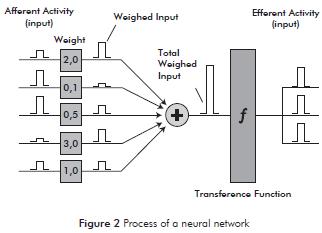
Mathematically expressed for a neuron:
Where:
a = network output
Wi, bj = connection weights
f = activation function
Topology of an Artificial Neuron
Generally, a neuron has more than one input and in turn, a neural network has more than one neuron. These neurons are grouped in layers; a layer is a set of neurons (Acosta, Zuluaga, & Salazar, 2000). In Figure 3 we see a neural network with 3 hidden layers and an input layer.

Each layer receives different names depending on its location (Acosta et al., 2000).
- Input Layer: Receives the network's input signals.
- Hidden Layers: Where most of the learning process occurs.
- Output Layer: Receives the information of the hidden layer and is where the final output signal of the model is generated.
3. MODEL DESCRIPTION
Below we present the considerations taken for the correct development of the model and in this way properly solve the physical problem.
Considerations
- In the Colorado Field logs we see that better development of the resistivity logs corresponds to better development of the spontaneous potential log; therefore it is possible to presume that with greater resistivity and better spontaneous potential, better reservoir quality conditions will be obtained.
- According to the latter, from the spontaneous potential logs and the short and deep resistivity logs, one can draft a petro-physical model that will allow estimating the porosity (φ) and other petro-physical variables of great interest to the analyst.
- The Neural Networks are a mathematical application that allows the identification of the patterns established as of the well log data; in this case Resistivity, Spontaneous Potential, and Sonic logs. According to the latter, the development of a model applied to Neural Networks in order to produce Sonic logs is viable and functional.
4. METHOD FOR THE DESIGN OF THE SYNTHETIC SONIC LOGS
According to the previously mentioned considerations, it is possible to solve the physical problem using Neural Networks, allowing the estimation of porosity of the dirt formation of the Colorado field, and obtaining a synthetic profile of the sonic logs. Below we describe the stages developed:
Stage 1. Collection and organization of available well log information of the wells within a determined formation. We made a well by well analysis and determined the inventory of logs of the Colorado field with which we could count on for the development of the project.
Stage 2. Correction of the Spontaneous Potential SP logs on the lutite base line (SP = 0) of the selected wells. This in order to decrease the associated noise of this input variable and thereby facilitate the identification of patterns during the Neural Network training process.
Stage 3. Creation of the training patterns with 30% of Colorado well data 75 while the remaining 70% is used for verification purposes (Mohaghegh, 1998). Training patterns and verification were normalized between 0 and 1.
Stage 4. Creation of several neural networks with differing topographies and different transference functions in each layer with Membrain Software. Training with the Backpropagation algorithm.
The output generated by each of the trained neural networks were evaluated in terms of the quadratic correlation (R2) coefficient, finding that the topography of the neural network that generated the best results was composed by three layers; an input layer, a hidden layer, and an output layer.
Stage 5. Generation of the SSL for wells that lack sonic logs, but that count on the SP logs and the two Resistivity logs (short and long).
5. RESULTS AND ANALYSIS
Quadratic Correlation Coefficient
The method used to generate the Synthetic Sonic Logs was based on the relationship existing amongst the spontaneous potential, resistivity, and sonic logs (DT), through the quadratic R2 correlation coefficient.
This analysis is important for the development of the well's SSL since it provides an estimate of the ease with which the Neural Network will find a relationship between the spontaneous potential logs and the resistivity logs, to later generate the well's synthetic sonic logs. Below we present the figures for each well:
Colorado 38
In comparing Figure 4 and 5, the greatest correlation is between the Spontaneous Potential logs and the Sonic logs data, obtaining a correlation coefficient of R2 = 0,2685. This reading is very small, indicating a very low correlation of data from the Colorado 38 well.
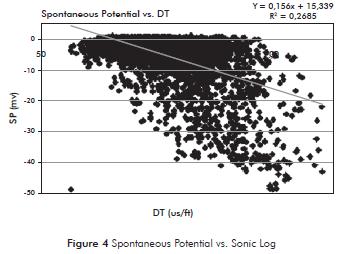

Colorado 70
In the Colorado 70 well the best correlation is in the Resistivity data (ILD), as can be seen in Figures 6 and 7. By using an exponential tendency we obtain a correlation coefficient of R2 = 0,3227. The correlation coefficient of the Spontaneous Potential data is R2 = 0,0039.
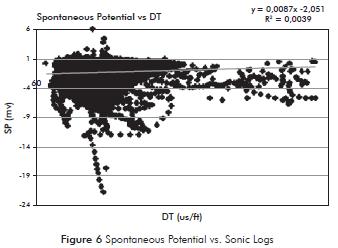
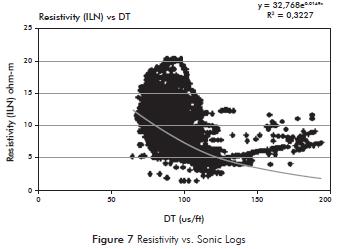
Colorado 72
In the Colorado 72 well the behavior of the Spontaneous Potential and Resistivity data in comparison to the Sonic logs are similar as can be seen in Figures 8 and 9. We obtained quadratic correlation coefficients of R2 = 0,122, and R2 = 0,189 respectively.
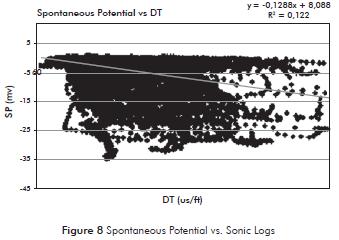
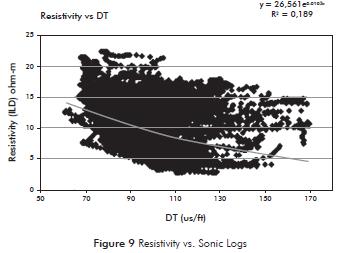
Colorado 75
The Colorado 75 well presents a greater correlation between Resistivity and Sonic (See Figures 10 and 11), compared to the Colorado 38, Colorado 70, and Colorado 72 wells. Its quadratic correlation coefficient is R2 = 0,5184 using potential approximation. For this reason the Colorado 75 well was taken as reference for the training of the Neural Network. The correlation coefficient of the Spontaneous potential data is R2 = 0,0039 (Figure 6). Below we present Table 1 with the R2 readings of the Colorado 38, Colorado 70, Colorado 72, and Colorado 75 wells.
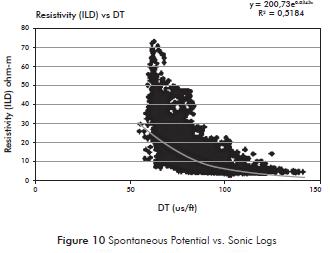
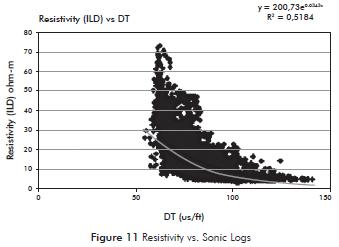
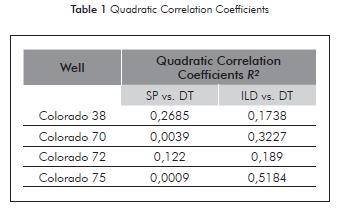
Topology of the Neural Network
The selection of the topology with which the best Synthetic Sonic Logs results were obtained was based in the readings obtained from the quadratic R2 correlation coefficient. This coefficient was obtained by graphing the readings of the true sonic logs vs. readings of the synthetic sonic logs provided by the tool, choosing in this manner the topology presenting the greatest coefficient. The topology found is the following:
- Input Layer. Composed of four neurons that correspond to the Depth, Spontaneous Potential (SP), Resistivity of the flushed zone (SN), and Resistivity of the uninvaded zone (ILD) readings. The transference function of the input neurons is the identity function.
- Hidden Layer. The hidden layer is composed of 28 neurons. The sigmoidal transference function is present in each of them.
- Output Layer. The output layer is the Synthetic Sonic Log (DT) and is composed of one neuron. Its transference function is the identity function.
Obtained Synthetic Sonic Logs
Once the Neural Network topology was found, we proceeded to generate the Synthetic Sonic Logs using GSSL with the verification data (70%), for the Colorado 70, Colorado 72, and Colorado 75 wells. The results obtained for each well are shown below:
Colorado 70
Figure 12 is the SSL generated for the verification data (70%) of the Colorado 70 well, where you can see that for this interval of the well, the generated data are of good quality, following closely the behavior of the well's Sonic logs in some zones; mainly in zones of high porosity.
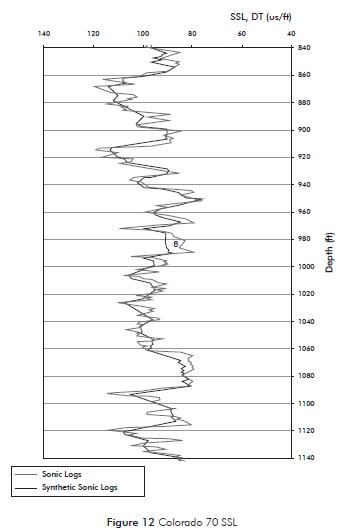
In the Colorado 70 well, 90% of the data of the Synthetic Sonic Logs generated using the tool present errors of less than 10%, indicating a good quadratic correlation coefficient of 0,69. 10% of the remaining data present error readings of between 10% and 25%, as can be analyzed in Figure 13.
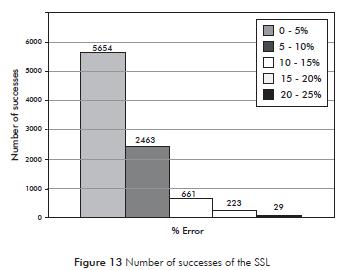
In this well the maximum error presented in the transit time (SSL) is of 25%, and the number of data with this associated error is minimal, of just 29 data out of 9030; which corresponds to 0,5%. According to the latter, the configuration of the Neural Network and the management of the explained data are helping to optimize the Synthetic Sonic Logs generation process in terms of calculated error.
Colorado 72
In this well the Synthetic Sonic Logs are of good quality; the deviations in respect to the original Sonic are not too big. This is due to the fact that the quadratic R2 correlation coefficient obtained with the tool is of approximately 0,7. Although there are still zones where the transit time is high and the tool does not generate said readings; as can be seen in Figure 14.
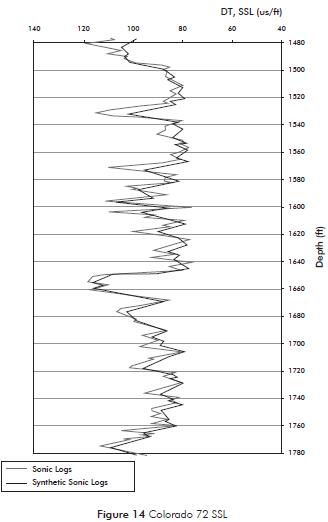
Analyzing Figure 15, we can conclude that approximately 53% of the Sonic logs data obtained with the tool (5419 readings), are below 5% error. On the other hand, 3137 data that correspond to 30% of the sample, present errors of between 5% and 10%. The number of data with moderate errors (10% - 20%) is 1079; equal to 10% of the sample.

Finally, just 7% of the data (737 data) present errors above 15%.
Colorado 75
The Colorado 75 well presents the greatest quadratic correlation coefficient with a reading of R2 = 0,7305. According to the latter, the SSL profile presents a behavior similar to the original well sonic logs, being able to generate high and low transit time readings (Figure 16).
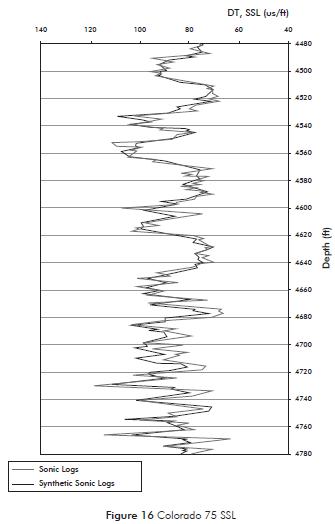
Figure 17 shows Successes of the Colorado 75 well.

The same as in the Colorado 70 well, the maximum calculated error reading in the data provided by the tool is of 25%. In the Colorado 75 well, 80% (3496 readings) of the data of the Synthetic Sonic Logs generated using the tool (GSSL), present errors below 10%, indicating a good correlation between the data of the original Sonic and the Synthetic Sonic. Transit times generated with errors above 15% are minimal, showing 255 data that are equal to 6% of the sample. These characteristics can be seen in Figure 17.
Table 2 shows the quadratic correlation coefficients for each well, using both tools (Membrain and GSSL).

As can be analyzed in Table 2, the quadratic correlation coefficient (R2) obtained with Membrain software, are very close to the readings provided with the tool created (GSSL). Due to this, one can conclude that the quality of the created tool is good and that the synthetic readings of the transit time obtained present minimal errors, if compared to the readings of the original Sonic logs for each well considered.
Once the quality of the tool was analyzed and knowing the topology of the neural network, we proposed the design of the Synthetic Sonic Logs for the Colorado 38 well, since the sonic profile of this well is of very bad quality due to the high transit time presented. The SSL is presented below.
Colorado 38
Figure 18 shows the Synthetic Sonic Logs generated with the tool (left track) for an interval of the formation of the Colorado 38 well and the original Sonic Logs (right track) for the same interval of the formation.
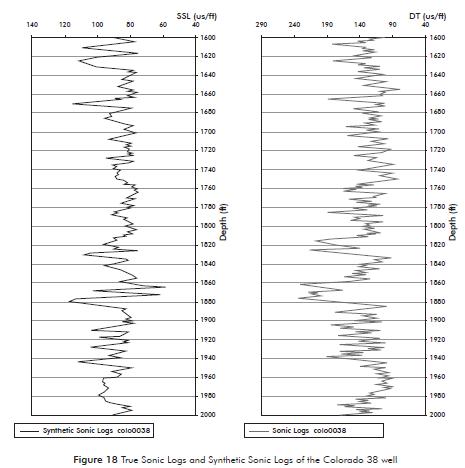
In this Figure we can see that the original sonic log of the well is bad quality due to the transit time readings present; these readings oscillate between 160 and 240 (μs/ft); while the synthetic sonic log readings oscillate between 60 and 120 (μs/ft); this is due to the fact that in the network training the transit time readings above 120 (μs/ft) were excluded since they are anomalous.
We can also see that the synthetic logs generated follow the behavior of the original Sonic logs of the well accurately and this is, in short, the object of the project: reproduce the Sonic Logs from common logs such as SP and resistivity.
The SSL reaches the tendency of the current Sonic logs but with inferior readings. What has been previously stated is a good indication that the network trained as of the method is generating acceptable transit time readings for the Colorado 38 well.
6. CONCLUSIONS
- The development of a method that allows the creation of the Synthetic Sonic logs from existing logs directly contributes to a better characterization of the reservoir.
- It is extremely important to count on the Sonic logs in the wells of a field, since by using this profile one can determine formation features such as clayey sand evaluation, identification of lithology, and porosity.
- Based on the analysis of the logs we conclude that the Colorado field is composed by a series of thin sand layers separated by large clay layers.
- With the proper development of the method the costs associated to the sonic logs in an oil field are reduced, optimizing the available resources.
- Artificial neural network is an alternate tool to solve problems that cannot be resolved with conventional mathematical methods in oil engineering.
- The generation of synthetic sonic logs with certain degree of precision is possible from the use of artificial neural networks.
- The GSSL tool created is a significant contribution to the hydrocarbon industry since it allows the creation of synthetic sonic logs of a well from the resistivity and spontaneous potential logs.
ACKNOWLEDGEMENTS
The authors wish to express their most sincere gratitude to the group of Research on Alternative Technologies for Hydrocarbons of the Universidad Industrial de Santander [Santander Industrial University], to the Universidad Industrial de Santander and to the Instituto Colombiano del Petróleo (ICP), for their technical and economic support. Also to Engineers Aristóbulo Bejarano-Wallens, Fernando-Enrique Calvete, and Elkin-Rodolfo Santafe, for the time spent and trust bestowed during the development of our project.
REFERENCES
Acosta, M., Zuluga, C., & Salazar, H. (2000). Tutorial de Redes Neuronales. Facultad de Ingeniería Eléctrica, Universidad Tecnológica de Pereira, Colombia. [ Links ]
Bendeck, J. (1992). Perfiles Eléctricos, Una herramienta para la evaluación de yacimientos. Asociación Colombiana de Geólogos y Geofísicos del Petróleo. Bogotá, Colombia. [ Links ]
Mohaghegh, S., Richardson, M., & Ameri, S. (1998). Virtual Magnetic Imaging Logs: Generation of Synthetic MRI Logs from Conventional Well Logs, SPE 51075, 9-11 November 1998, Pittsburgh, Pennsylvania. [ Links ]
Mohaghegh, S. (2000). Virtual intelligence applications in Petroleum Engineering: Part 1 - Artificial Neural Networks. SPE 58046, JPT, 52 (9): 64-73, September 2000. [ Links ]















